Kenyan wildlife policies must extend beyond protected areas

At least 15% of the world’s surface is governed by laws to protect its living species, including plants, animals and fungi. But this is not enough. The most recent estimates suggest that an additional 30% of the planet’s surface needs further conservation attention.
Without this additional protection the world will continue to lose large numbers of species.
What does this look like when we scale down to the country level?
Our research focuses on Kenya – a country renowned for its natural environment, in particular its large mammals such as elephants, rhinos and lions. We looked into whether Kenya’s protected areas and policies adequately conserve its less well known mammals, birds, and amphibians.
We examined a total of 1,535 species. We used this snapshot of the country’s biodiversity because of the availability of data for these groups and because many are under threat.
In Kenya, protected areas that are governed by wildlife laws fall under three categories. These are: national parks (managed by the Kenya Wildlife Service), national reserves (managed by county governments) and conservancies. National parks and reserves cover about 8% of the country’s land surface. About 160 conservancies protect about 11% of Kenya’s land.
These protected areas were generally established in areas with large populations of big mammals and are the focus of the current wildlife policy. This policy aims to protect these species inside national parks and reserves and help landowners coexist with wildlife in conservancies. It gives landowners the right to benefit from wildlife, for example through revenue from eco-toursim and compensation for the costs of living with wildlife.
The number of wildlife conservancies has grown to protect the many of the large mammals which are found outside government protected areas.
Despite this, we found that only 16% of amphibian species, 45% of birds, and 41% of mammals are adequately conserved within government run protected areas and conservancies. Many species need attention in areas that are not supported by wildlife policies or laws.
Kenya is developing a new wildlife policy and conservation master plan. Protected areas and conservancies must be supported. But our research shows that new and innovative wildlife policies and practices are needed to adequately protect many of Kenya’s species.
Collecting data
For our study, we developed a data set that categorised land into different types of use:
- protected areas and conservancies (which are covered by current wildlife policy),
- forest reserves (managed by Kenya Forest Service),
- rangelands (areas grazed by livestock),
- forests, urban areas and agriculture.
We then used data from the International Union for Conservation of Nature database and Birdlife International to examine whether a species’ range was within a protected area, which other land-use options were important for conservation and which species needed more of their range to be protected.
Finally we used data on the human footprint – which includes information on built environments, cropland, human population density, night‐time lights, railways and roads. It allowed us to assess how pressure from people affects various species and which types of land use exert the highest pressures.
Inadequate protected areas
We found that many of the areas with the highest numbers of different species are found where considerable human pressures exist. These are often farmland areas, close to development, or rangelands. Substantial conservation efforts outside protected areas, and beyond the current policy focus, are required to ensure the longevity of these species in Kenya.
Worryingly, 80 species weren’t covered by any protected area at all. Many face immediate threats from human activities to their survival – such as the critically endangered Taita warty frog (Callulina dawida).
The highest density of large mammals is found in areas with the lowest human pressures. This is currently where wildlife policy focuses. Yet we show with locally acquired data that the number of bird and plant species can be highest in areas with considerable human pressures.
This same trend can be found in wildlife policies across much of the continent: a focus on protected areas and large mammals, with little consideration for broader biodiversity in systems dominated by humans.
Rangelands, farms and cities
Of all land uses we assessed, rangelands – which cover 67% of the country and mostly drier areas – are extremely important for conservation efforts. They cover the largest area of land and provide range for the majority of species.
Conserving wildlife and biodiversity in rangelands, which are dominated by livestock, is both possible and necessary.
People and animals can co-exist in these areas. For instance in Kenya’s rift valley there are communities that protect large tracts of land to support the free movement of people, livestock and wildlife.
Urban and agricultural areas are often overlooked and are also important for conservation.
For instance, there’s a mosaic of green space in the Kenyan capital, Nairobi – in the form of a national park, urban parks, forest reserves and residential gardens. It hosts as many bird species as the Maasai Mara national reserve. As cities grow, urban planning needs to consider biodiversity.
Lessons can be learnt from cities such as London and Washington DC. London, for example, supports key species by protecting open spaces and their habitat.
Taking care of forest patches within farmland is also crucial. In southern Uganda, for example, preserving forest patches in intensive agricultural land may benefit some bird species.
Future conservation efforts
Kenya needs to prioritise conservation interventions at the national level, across land-use types to conserve a large number of its mammals, birds and amphibians. To do this, policymakers must use data to identify key areas of habitat and species range that can be conserved.
Kenya should also develop “National Red Lists”, as has been done in Uganda and South Africa. This could help target action for threatened species.
To monitor progress, there should be local programmes to collect and summarise data on the environment, biodiversity, land use, human demographics and economic indicators. This will help to prioritise action too.
Our research echoes international calls for landscape‐based approaches to conservation. The call is to balance competing land uses in a way that is best for human well-being and the environment. This would mean policy reforms that integrate conservation with all other sectors of land use.
Without this, landscapes in Africa may end up in a similar situation to those of Europe and America, needing expensive, large-scale restoration and recovery strategies to protect biodiversity.
Peadar Brehony, PhD Candidate (University of Cambridge), who has focused on the impact that conservation efforts have on socio-ecological systems, contributed to this article.![]()
Peter Tyrrell, PhD Candidate and Mistler Graduate Scholar, University of Oxford
This article is republished from The Conversation under a Creative Commons license. Read the original article.






